糖尿病英文简介
- 格式:docx
- 大小:11.40 KB
- 文档页数:1

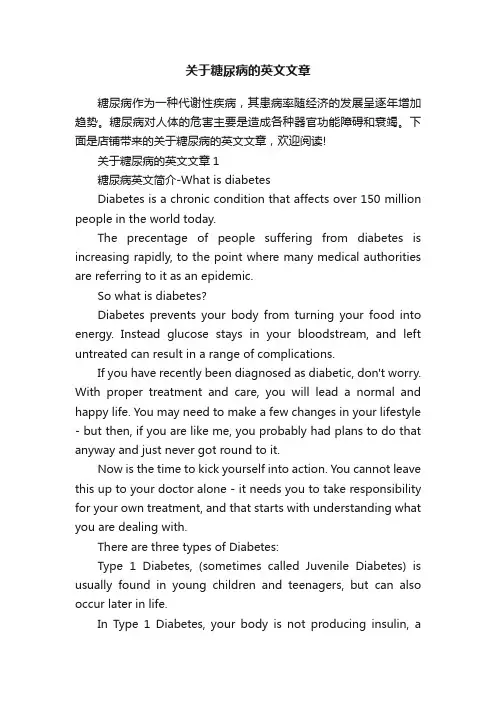
关于糖尿病的英文文章糖尿病作为一种代谢性疾病,其患病率随经济的发展呈逐年增加趋势。
糖尿病对人体的危害主要是造成各种器官功能障碍和衰竭。
下面是店铺带来的关于糖尿病的英文文章,欢迎阅读!关于糖尿病的英文文章1糖尿病英文简介-What is diabetesDiabetes is a chronic condition that affects over 150 million people in the world today.The precentage of people suffering from diabetes is increasing rapidly, to the point where many medical authorities are referring to it as an epidemic.So what is diabetes?Diabetes prevents your body from turning your food into energy. Instead glucose stays in your bloodstream, and left untreated can result in a range of complications.If you have recently been diagnosed as diabetic, don't worry. With proper treatment and care, you will lead a normal and happy life. You may need to make a few changes in your lifestyle - but then, if you are like me, you probably had plans to do that anyway and just never got round to it.Now is the time to kick yourself into action. You cannot leave this up to your doctor alone - it needs you to take responsibility for your own treatment, and that starts with understanding what you are dealing with.There are three types of Diabetes:Type 1 Diabetes, (sometimes called Juvenile Diabetes) is usually found in young children and teenagers, but can also occur later in life.In Type 1 Diabetes, your body is not producing insulin, ahormone needed to convert blood sugar into energy. Normally this hormone is produced by cells in your pancreas, but for some reason this is not happening as it should.As the glucose in your blood can't be converted into energy and absorbed by your cells, it builds up causing high blood sugar.Left untreated, high blood sugar can cause serious long-term health problems.The normal treatment for people with type 1 diabetes is daily injections of insulin which keeps the blood sugar level within normal ranges.Finding out you have diabetes can be upsetting, but it should not prevent you from living a long and happy life.If you think this condition will prevent you leading an active life, consider Sir Steve Redgrave, one of the World's greatest Olympic athletes.Sir Steve battled type 1 diabetes to win his record-breaking fifth Olympic Gold medal at the Sydney games in the coxless fours rowing event!Type 2 diabetes (sometimes called mature onset diabetes) is the most common form of diabetes.As with Type 1 Diabetes, the problem is related to insulin, a hormone needed to convert sugar into energy.With Type 2 diabetes your body might be producing too little insulin, or it might not be reacting to the insulin correctly. Either way, the end result is that glucose builds up in the bloodstream instead of going into the cells. Left untreated, high blood sugar can cause serious long-term health problems.Type 2 diabetes usually appears later in life, often between the ages of 35-45 years. As it often develops slowly, many people may not recognise the symptoms, and may have diabeteswithout knowing it.If you have recently been diagnosed with type 2 diabetes, you are one of the lucky ones. Many people have diabetes without knowing it, and are at much greater risk of long term medical complications.Finding out you have diabetes can be upsetting, but it should not prevent you from living a long and happy life. You may need to make a few changes in your lifestyle, but these changes are also good advice for non-diabetics, so probably a good idea anyway.Gestational diabetes is a type of diabetes, that is only suffered by pregnant women.In Gestational diabetes, a woman’s blood sugar is hig her than normal because of the other hormones pridcued during preganancy interfere with the insulin that is produced naturally.Gestational diabetes usually becomes apparent during the 24th to 28th weeks of pregnancy, and, in most cases, disappears of its own accord once the baby is born.Women with gestational diabetes usually do NOT have an increased risk of having a baby with birth defects.Generally, sufferers of gestational diabetes have normal blood sugar levels during the critical first stages of the preganancy.Whilst there can be complications caused by gestational diabetes, these can usually be managed by careful attention to nutrition and blood sugar levels.Approximately 3 to 5 percent of all pregnant women in the developed world suffer from gestational diabetes.关于糖尿病的英文文章2医学英语糖尿病专业词汇A1C –Hemoglobin A1c 醣化血色素A-II receptor antagonist/blockers-ARA [ARB]血管张力素II 接受体拮抗剂/阻断剂A chain,insulin, 胰岛素α链Acanthosis nigrans, 皮肤棘状黑色素瘤Acarbose,一种α-葡萄苷酶抑制剂 ,Acarbose [Glucobay-Bayer] Accountability measures 质量改善度评量ACCU-Check Compact-Roche Diabetes Monitoring Kit 一种携带型血糖机Accupril --Quinapril [Acupril-Parke Davis]之商品名ACEI=ACE inhibitor 血管张力素转化酶抑制剂 [ACEI 非正式名词] ACE inhibitors 血管张力素转化酶抑制剂ACE-K煮甜甜--Acesulfame Potassium [煮甜甜—益富]一种Sweatener 甜味矫味剂Aceon--Perindopril [Aceon-Solvay] [Acertil-Servier]一种血管张力素转换酶抑制剂Acertil--Perindopril [Aceon-Solvay] [Acertil-Servier]一种血管张力素转换酶抑制剂Acesulfame Potassium =ACE-K [煮甜甜—益富]- 一种Sweatener 甜味矫味剂,Adalat--Nifedipine [Adalat-Bayer] [Adalat OROS-Bayer] 一种钙离子径路阻断剂Adalat OROS--Nifedipine[Adalat OROS-Bayer]一种钙离子径路阻断剂长效型Adhesion molecule 黏着分子与动脉硬化形成有关,可被HDL 抑制Acertil --Perinodopril [Acertil-Servier]商品名,属于ACE inhibitor用于糖尿肾病变Acetoacetate 乙酰乙酸盐乙酰醋酸Acetohexamide 口服降糖药物 Acetohexamide [Dymelor-Lilly]Acetone 丙酮Acetylsalicylic acid: [Aspirin-Bayer],乙酰水杨酸,阿司匹林Acidosis 酸血症Acipimox [Olbetam-Pharmacia] 烟碱酸类降脂剂Acromegaly肢端肥大症Action--Insulin 胰岛素之作用Actos –Pioglitazone,Insulin sensitizer胰岛素敏感度反应性增强剂新降血糖药物Actrapid Human Insulin-Novo Regular, Human insulin快速作用型人体胰岛素Acute myocardial infarction急性心肌梗塞ADA=American Diabetes Association 美国糖尿病学会Additive--Insulin胰岛素制剂之添加剂ADDQOL=Adult of Diabetes Dependent QOL成人糖尿病相应生活质量Adhesion--Insulin 胰岛素沾粘性Adrenergic blockers交感神经阻断剂Aducut--Delapril [Adecut-武田] 一种血管张力素转换酶抑制剂Adult of Diabetes Dependent QOL=ADDQOL成人糖尿病相应生活质量Adult Treatment Panel III , National Cholesterol education Program =NCEP ATP IIIAER Albumin excretion rate尿液白蛋白排出率。
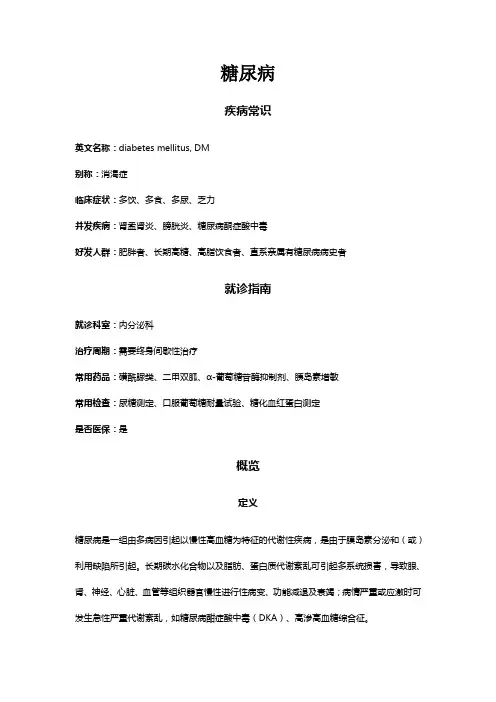
糖尿病疾病常识英文名称:diabetes mellitus, DM别称:消渴症临床症状:多饮、多食、多尿、乏力并发疾病:肾盂肾炎、膀胱炎、糖尿病酮症酸中毒好发人群:肥胖者、长期高糖、高脂饮食者、直系亲属有糖尿病病史者就诊指南就诊科室:内分泌科治疗周期:需要终身间歇性治疗常用药品:磺酰脲类、二甲双胍、α-葡萄糖苷酶抑制剂、胰岛素增敏常用检查:尿糖测定、口服葡萄糖耐量试验、糖化血红蛋白测定是否医保:是概览定义糖尿病是一组由多病因引起以慢性高血糖为特征的代谢性疾病,是由于膜岛素分泌和(或)利用缺陷所引起。
长期碳水化合物以及脂肪、蛋白质代谢紊乱可引起多系统损害,导致眼、肾、神经、心脏、血管等组织器官慢性进行性病变、功能减退及衰竭;病情严重或应激时可发生急性严重代谢紊乱,如糖尿病酣症酸中毒(DKA)、高渗高血糖综合征。
流行病学糖尿病是常见病、多发病,目前在全球范围内,糖尿病的患病率与发病率极攀升。
1.以2型糖尿病为例,2013年全国调查中2型糖尿病患病率为10.4%,男性高于女性(11.1%比9.6%)。
2.各民族间的糖尿病患病率存在较大差异:满族15.0%、汉族14.7%、维吾尔族12.2%、壮族12.0%、回族10.6%、藏族4.3%。
3.未诊断糖尿病比例较高。
2013年全国调查中,未诊断的糖尿病患者占总数的63%。
4.肥胖和超重人群糖尿病患病率显著增加,肥胖人群糖尿病患病率升高了2倍。
2013年按体质指数(BMI)分层显示,BMI<25 kg/m^2者糖尿病患病率为7.8%、25 kg/m2≤BMI<30 kg/m^2者患病率为15.4%,BMI≥30 kg/m^2者患病率为21.2%。
疾病分类我国目前采用WHO1999年的病因学分型体系,将糖尿病分为以下四大类:1.1型糖尿病:胰岛B细胞破坏,导致胰岛素绝对缺乏。
又分为免疫介导性和特发性(无自身免疫证据)。
2.2型糖尿病:以胰岛素抵抗为主伴胰岛素进行性分泌不足和以胰岛素进行性分泌不足为主伴胰岛素抵抗。

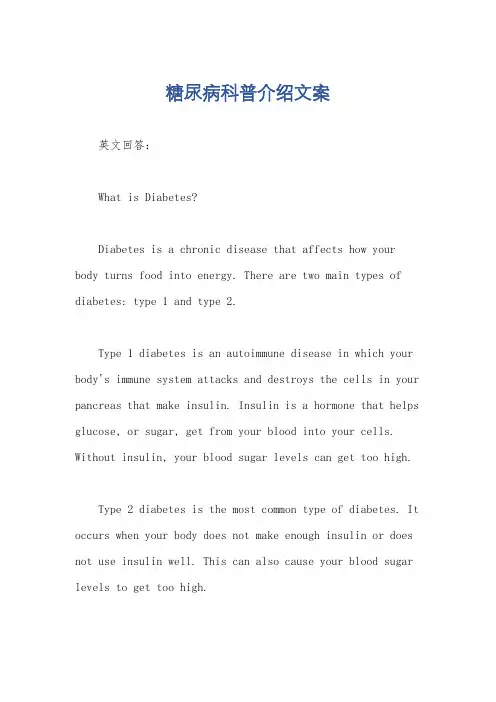
糖尿病科普介绍文案英文回答:What is Diabetes?Diabetes is a chronic disease that affects how your body turns food into energy. There are two main types of diabetes: type 1 and type 2.Type 1 diabetes is an autoimmune disease in which your body's immune system attacks and destroys the cells in your pancreas that make insulin. Insulin is a hormone that helps glucose, or sugar, get from your blood into your cells. Without insulin, your blood sugar levels can get too high.Type 2 diabetes is the most common type of diabetes. It occurs when your body does not make enough insulin or does not use insulin well. This can also cause your blood sugar levels to get too high.Symptoms of Diabetes.The symptoms of diabetes can vary depending on the type of diabetes you have. However, some common symptoms include:Increased thirst.Frequent urination.Unexplained weight loss.Fatigue.Blurred vision.Slow-healing sores.Frequent infections.Risk Factors for Diabetes.There are a number of risk factors for diabetes,including:Family history of diabetes.Obesity.Physical inactivity.Age (over 45)。
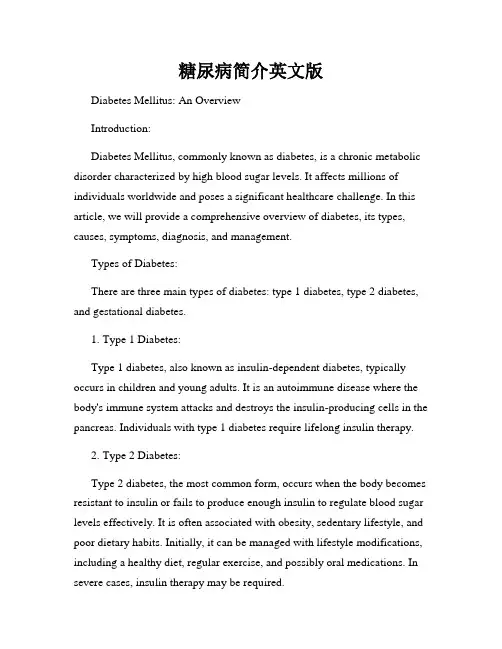
糖尿病简介英文版Diabetes Mellitus: An OverviewIntroduction:Diabetes Mellitus, commonly known as diabetes, is a chronic metabolic disorder characterized by high blood sugar levels. It affects millions of individuals worldwide and poses a significant healthcare challenge. In this article, we will provide a comprehensive overview of diabetes, its types, causes, symptoms, diagnosis, and management.Types of Diabetes:There are three main types of diabetes: type 1 diabetes, type 2 diabetes, and gestational diabetes.1. Type 1 Diabetes:Type 1 diabetes, also known as insulin-dependent diabetes, typically occurs in children and young adults. It is an autoimmune disease where the body's immune system attacks and destroys the insulin-producing cells in the pancreas. Individuals with type 1 diabetes require lifelong insulin therapy.2. Type 2 Diabetes:Type 2 diabetes, the most common form, occurs when the body becomes resistant to insulin or fails to produce enough insulin to regulate blood sugar levels effectively. It is often associated with obesity, sedentary lifestyle, and poor dietary habits. Initially, it can be managed with lifestyle modifications, including a healthy diet, regular exercise, and possibly oral medications. In severe cases, insulin therapy may be required.3. Gestational Diabetes:Gestational diabetes develops during pregnancy and usually resolves after childbirth. It occurs when hormonal changes during pregnancy lead to insulin resistance. If left uncontrolled, it can pose risks for both the mother and the baby. Proper monitoring and management are crucial to prevent complications.Causes of Diabetes:The causes of diabetes vary depending on the type:1. Type 1 Diabetes:The exact cause of type 1 diabetes is unknown, but it is believed to be a combination of genetic and environmental factors. Certain genes make individuals more susceptible to developing type 1 diabetes, and environmental triggers, such as viral infections, may initiate the autoimmune response.2. Type 2 Diabetes:Type 2 diabetes is primarily attributed to lifestyle factors, including obesity, physical inactivity, unhealthy eating habits, and genetic predisposition. Excessive body weight and abdominal fat accumulation increase insulin resistance, leading to elevated blood sugar levels.3. Gestational Diabetes:The hormonal changes during pregnancy are the main cause of gestational diabetes. These hormones can obstruct the action of insulin, resulting in high blood sugar levels.Symptoms of Diabetes:The symptoms of diabetes can vary, but some common signs include:1. Frequent urination2. Excessive thirst3. Unexplained weight loss4. Fatigue5. Blurred vision6. Slow healing of wounds7. Tingling sensation or numbness in the hands and feetDiagnosis of Diabetes:Diabetes can be diagnosed through various tests, including:1. Fasting Plasma Glucose Test: Measures blood sugar levels after fasting for at least 8 hours.2. Oral Glucose Tolerance Test: Measures blood sugar levels before and 2 hours after consuming a glucose-rich drink.3. Glycated Hemoglobin (HbA1c) Test: Measures average blood sugar levels over the past three months.Management of Diabetes:Diabetes management aims to keep blood sugar levels within the target range to prevent complications. It primarily involves:1. Healthy Eating: A well-balanced diet rich in fruits, vegetables, whole grains, lean proteins, and healthy fats is essential. Avoiding sugary foods and drinks helps control blood sugar levels.2. Regular Exercise: Engaging in physical activity for at least 150 minutes per week helps improve insulin sensitivity and regulate blood sugar levels.3. Medications: Depending on the type and severity of diabetes, oral medications, injectable drugs, or insulin may be prescribed to manage blood sugar levels effectively.4. Regular Monitoring: Regular monitoring of blood sugar levels and periodic check-ups with healthcare professionals are crucial for adjusting treatment plans and preventing complications.Conclusion:Diabetes Mellitus is a chronic condition requiring lifelong management. Understanding the types, causes, symptoms, diagnosis, and management strategies is crucial in effectively controlling blood sugar levels and preventing complications. By adopting a healthy lifestyle and working closely with healthcare professionals, individuals with diabetes can lead fulfilling lives and minimize the risks associated with the disease.。
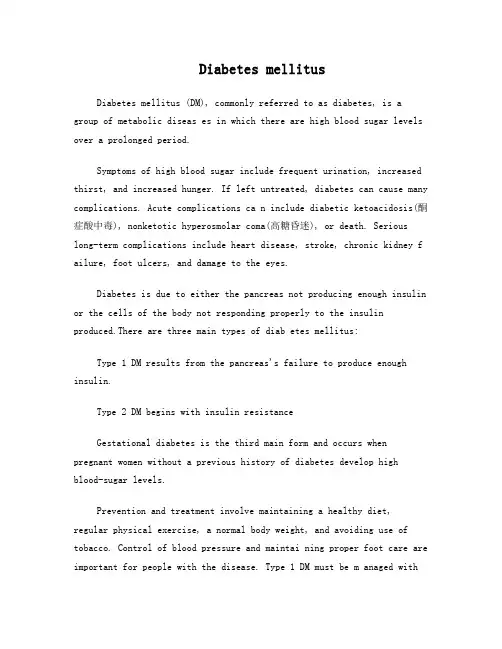
Diabetes mellitusDiabetes mellitus (DM), commonly referred to as diabetes, is a group of metabolic diseas es in which there are high blood sugar levels over a prolonged period.Symptoms of high blood sugar include frequent urination, increased thirst, and increased hunger. If left untreated, diabetes can cause many complications. Acute complications ca n include diabetic ketoacidosis(酮症酸中毒), nonketotic hyperosmolar coma(高糖昏迷), or death. Serious long-term complications include heart disease, stroke, chronic kidney f ailure, foot ulcers, and damage to the eyes.Diabetes is due to either the pancreas not producing enough insulin or the cells of the body not responding properly to the insulin produced.There are three main types of diab etes mellitus:Type 1 DM results from the pancreas's failure to produce enough insulin.Type 2 DM begins with insulin resistanceGestational diabetes is the third main form and occurs when pregnant women without a previous history of diabetes develop highblood-sugar levels.Prevention and treatment involve maintaining a healthy diet,regular physical exercise, a normal body weight, and avoiding use of tobacco. Control of blood pressure and maintai ning proper foot care are important for people with the disease. Type 1 DM must be m anaged withinsulin injections.Type 2 DM may be treated with medications with or witho ut insulin.Insulin and some oral medications can cause low blood sugar.Weight loss surger y in those with obesity is sometimes an effective measure in those with type 2 DM.Gest ational diabetes usually resolves after the birth of the baby.。

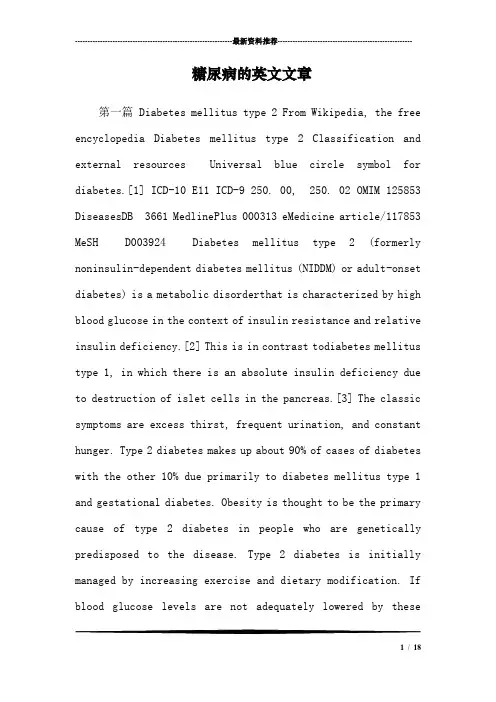
---------------------------------------------------------------最新资料推荐------------------------------------------------------糖尿病的英文文章第一篇 Diabetes mellitus type 2 From Wikipedia, the free encyclopedia Diabetes mellitus type 2 Classification and external resources Universal blue circle symbol for diabetes.[1] ICD-10 E11 ICD-9 250. 00, 250. 02 OMIM 125853 DiseasesDB 3661 MedlinePlus 000313 eMedicine article/117853 MeSH D003924 Diabetes mellitus type 2 (formerly noninsulin-dependent diabetes mellitus (NIDDM) or adult-onset diabetes) is a metabolic disorderthat is characterized by high blood glucose in the context of insulin resistance and relative insulin deficiency.[2] This is in contrast todiabetes mellitus type 1, in which there is an absolute insulin deficiency due to destruction of islet cells in the pancreas.[3] The classic symptoms are excess thirst, frequent urination, and constant hunger. Type 2 diabetes makes up about 90% of cases of diabetes with the other 10% due primarily to diabetes mellitus type 1 and gestational diabetes. Obesity is thought to be the primary cause of type 2 diabetes in people who are genetically predisposed to the disease. Type 2 diabetes is initially managed by increasing exercise and dietary modification. If blood glucose levels are not adequately lowered by these1 / 18measures, medications such as metformin or insulin may be needed. In those on insulin, there is typically the requirement to routinely check blood sugar levels. Rates of type 2 diabetes have increased markedly over the last 50 years in parallel with obesity: As of 2010 there are approximately 285 million people with the disease compared to around 30 million in 1985.[4][5]Long-term complications from high blood sugar can include heart disease,strokes, diabetic retinopathy where eyesight is affected, kidney failurewhich may require dialysis, and poor circulation of limbs leading toamputations. The acute complication of ketoacidosis, a feature of type 1 diabetes, is uncommon.[6] However, nonketotic hyperosmolar coma may occur. Contents [hide] 1 Signs and symptoms o 1. 1 Complications2 Cause o 2. 1 Lifestyle o 2. 2 Genetics o 2.3 Medical conditions3 Pathophysiology4 Diagnosis5 Screening6 Prevention7 Management o 7. 1 Lifestyle o 7. 2 Medications o 7. 3 Surgery8 Epidemiology9 History 10 References 11 External links Signs and symptoms Overview of the most significant symptoms of diabetes. The classic symptoms of diabetes are polyuria (frequent urination), polydipsia (increased thirst), polyphagia (increased hunger), and weight loss.[7] Other symptoms that are commonly present at diagnosis include: a---------------------------------------------------------------最新资料推荐------------------------------------------------------ history of blurred vision,itchiness, peripheral neuropathy, recurrent vaginal infections, and fatigue. Many people, however, have no symptoms during the first few years and are diagnosed on routine testing. People with type 2 diabetes mellitus may rarely present with nonketotic hyperosmolar coma (a condition of very high blood sugar associated with a decreased level of consciousness and low blood pressure).[3] Complications Main article: Complications of diabetes mellitus Type 2 diabetes is typically a chronic disease associated with a ten-year-shorter life expectancy.[4] This is partly due to a number of complications with which it is associated, including: two to four times the risk of cardiovascular disease, includingischemic heart disease and stroke; a 20-fold increase in lower limb amputations, and increased rates of hospitalizations.[4] In the developed world, and increasingly elsewhere, type 2 diabetes is the largest cause of nontraumatic blindnessand kidney failure.[8] It has also been associated with an increased risk of cognitive dysfunction and dementiathrough disease processes such as Alzheimer’s disease and vascular dementia.[9] Other complications include:acanthosis nigricans, sexual dysfunction, and3 / 18frequent infections.[7] Cause The development of type 2 diabetes is caused by a combination of lifestyle and genetic factors.[8][10] While some are under personal control, such as diet and obesity, others, such as increasing age, female gender, and genetics, are not.[4] A lack of sleep has been linked to type 2 diabetes.[11] This is believed to act through its effect on metabolism.[11] The nutritional status of a mother during fetal development may also play a role, with one proposed mechanism being that of altered DNA methylation.[12] Lifestyle Main article: Lifestyle causes of diabetes mellitus type 2 A number of lifestyle factors are known to be important to the development of type 2 diabetes, including:obesity (defined by a body mass index of greater than thirty), lack of physical activity, poor diet, stress, and urbanization.[4] Excess body fat is associated with 30% of cases in those of Chinese and Japanese descent, 60-80% of cases in those of European and African descent, and 100% of Pima Indians and Pacific Islanders.[3]Those who are not obese often have a high waisthip ratio.[3] Dietary factors also influence the risk of developing type 2 diabetes. Consumption of sugar-sweetened drinks in excess is associated with an increased risk.[13][14] The type of fats in the diet are also important, withsaturated fats and---------------------------------------------------------------最新资料推荐------------------------------------------------------ trans fatty acids increasing the risk and polyunsaturated and monounsaturated fat decreasing the risk.[10] Eating lots of white rice appears to also play a role in increasing risk.[15] A lack of exercise is believed to cause 7% of cases.[16] Genetics Main article: Genetic causes of diabetes mellitus type2 Most cases of diabetes involve many genes, with each beinga small contributor to an increased probability of becoming a type 2 diabetic.[4] If one identical twin has diabetes, the chance of the other developing diabetes within his lifetime is greater than 90% while the rate for nonidentical siblings is 25-50%.[3]As of 2019, more than 36 genes have been found that contribute to the risk of type 2 diabetes.[17] All of these genes together still only account for 10% of the total heritable component of the disease. The TCF7L2allele, for example, increases the risk of developing diabetes by 1.5 times and is the greatest risk of the common genetic variants. Most of the genes linked to diabetes are involved in beta cell functions.[3] There are a number of rare cases of diabetes that arise due to an abnormality in a single gene (known asmonogenic forms of diabetes or other specific types of diabetes).[3][4] These include maturity onset diabetes of the young (MODY), Donohue5 / 18syndrome, and Rabson-Mendenhall syndrome, among others.[4] Maturity onset diabetes of the young constitute 15% of all cases of diabetes in young people.[18] Medical conditions There are a number of medications and other health problems that can predispose to diabetes.[19] Some of the medications include: glucocorticoids, thiazides, beta blockers, atypical antipsychotics,[20] andstatins.[21]Those who have previously had gestational diabetes are at a higher risk of developing type 2 diabetes.[7] Other health problems that are associated include: acromegaly, Cushing’s syndrome, hyperthyroidism,pheochromocytoma, and certain cancers such as glucagonomas.[19] Testosterone deficiency is also associated with type 2 diabetes.[22][23] Pathophysiology Type 2 diabetes is due to insufficient insulin production from beta cells in the setting of insulin resistance.[3] Insulin resistance, which is the inability of cells to respond adequately to normal levels of insulin, occurs primarily within the muscles, liver, and fat tissue.[24] In the liver, insulin normally suppresses glucose release. However, in the setting of insulin resistance, the liver inappropriately releases glucose into the blood.[4] The proportion of insulin resistance versus beta cell dysfunction differs among individuals, with some having---------------------------------------------------------------最新资料推荐------------------------------------------------------7 / 18primarily insulin resistance and only a minor defect in insulin secretion and others with slight insulin resistance and primarily a lack of insulin secretion.[3] Other potentially important mechanisms associated with type 2 diabetes and insulin resistance include: increased breakdown of lipids within fat cells, resistance to and lack of incretin, high glucagon levels in the blood, increased retention of salt and water by the kidneys, and inappropriate regulation of metabolism by thecentral nervous system.[4] However, not all people with insulin resistance develop diabetes, since an impairment of insulin secretion by pancreatic beta cells is also required.[3] Diagnosis The World Health Organizationdefinitionofdiabetes (both type 1 and type 2) is for a single raised glucose reading with symptoms, otherwise tolerance test, two hours after the oral dose a plasma glucose 11.1 mmol/l (200 mg/dl) A random blood sugar of greater than 11.1 mmol/l (200 mg/dL) in association with typical symptoms[7] or aglycated hemoglobin (HbA1c) of greater than 6.5% is another method of diagnosing diabetes.[4] In 2009 an InternationalExpert Committee that included representatives of the American Diabetes Association (ADA), the International Diabetes Federation (IDF), and the European Association for the Study of Diabetes (EASD) recommended that a threshold of 6.5% HbA1c should be used to diagnose diabetes. This recommendation was adopted by the American Diabetes Association in 2010.[28] Positive tests should be repeated unless the person presents with typical symptoms and blood sugars 11.1 mmol/l (200 mg/dl).[29] Threshold for diagnosis of diabetes is based on the relationship between results of glucose tolerance tests, fasting glucose or HbA1c and complications such as retinal problems.[4] A fasting or random blood sugar is preferred over the glucose tolerance test, as they are more convenient for people.[4] HbA1c has the advantages that fasting is not required and results are more stable but has the disadvantage that the test is more costly than measurement of blood glucose.[30] It is estimated that 20% of people with diabetes in the United States do not realize that they have the disease.[4] Diabetes mellitus type 2 is characterized by high blood glucose in the context of insulin resistance and relative insulin deficiency.[2] This is in contrast to diabetes mellitus type 1 in which there is an absolute insulin deficiency due to---------------------------------------------------------------最新资料推荐------------------------------------------------------ destruction of islet cells in the pancreas and gestational diabetes mellitus that is a new onset of high blood sugars in associated with pregnancy.[3] Type 1 and type 2 diabetes can typically be distinguished based on the presenting circumstances.[29] If the diagnosis is in doubt antibody testing may be useful to confirm type 1 diabetes and C-peptide levels may be useful to confirm type 2 diabetes,[31] with C-peptide levels normal or high in type 2 diabetes, but low in type 1 diabetes. Screening No major organization recommends universal screening for diabetes as there is no evidence that such a program would improve outcomes.[32] Screening is recommended by the United States Preventive Services Task Force in adults without symptoms whose blood pressure is greater than 135/80 mmHg.[33] For those whose blood pressure is less, the evidence is insufficient to recommend for or against screening.[33] The World Health Organizationrecommends only testing those groups at high risk.[32] High-risk groups in the United States include: those over 45 years old; those with a first degree relative with diabetes; some ethnic groups, including Hispanics, African-Americans, and Native-Americans;a history of gestational diabetes; polycystic ovary syndrome;9 / 18excess weight; and conditions associated with metabolic syndrome.[7] Prevention Main article: Prevention of diabetes mellitus type 2 Onset of type 2 diabetes can be delayed or prevented through proper nutrition and regular exercise.[34][35]Intensive lifestyle measures may reduce the risk by over half.[8] The benefit of exercise occurs regardless of the person’s initial weight or subsequent weight loss.[36] Evidence for the benefit of dietary changes alone, however, is limited,[37] with some evidence for a diet high in green leafy vegetables[38] and some for limiting the intake of sugary drinks.[13] In those with impaired glucose tolerance, diet and exercise either alone or in combination with metformin or acarbose may decrease the risk of developing diabetes.[8][39] Lifestyle interventions are more effective than metformin.[8] Management Further information: Diabetes management Management of type 2 diabetes focuses on lifestyle interventions, lowering other cardiovascular risk factors, and maintaining blood glucose levels in the normal range.[8] Self-monitoring of blood glucose for people with newly diagnosed type 2 diabetes was recommended by the British National Health Service in 2008,[40] however the benefit of self monitoring in those not using multi-dose insulin is---------------------------------------------------------------最新资料推荐------------------------------------------------------ questionable.[8][41] Managing other cardiovascular risk factors, such as hypertension, high cholesterol, and microalbuminuria, improves a person’s life expectancy.[8] Intensive blood pressure management (less than 130/80 mmHg) as opposed to standard blood pressure management (less than 140160/85100 mmHg) results in a slight decrease in stroke risk but no effect on overall risk of death.[42] Intensive blood sugar lowering (HbA1c6%) as opposed to standard blood sugar lowering (HbA1c of 77.9%) does not appear to change mortality.[43][44] The goal of treatment is typically an HbA1c of less than 7% or a fasting glucose of less than 6.7 mmol/L (120 mg/dL) however these goals may be changed after professional clinical consultation, taking into account particular risks of hypoglycemia and life expectancy.[7] It is recommended that all people with type 2 diabetes get regular ophthalmology examination.[3] Lifestyle A proper diet and exercise are the foundations of diabetic care,[7] with a greater amount of exercise yielding better results.[45] Aerobic exercise leads to a decrease in HbA1c and improved insulin sensitivity.[45]Resistance training is also useful and the combination of both types of exercise may be most11 / 18effective.[45] Adiabetic diet that promotes weight loss is important.[46] While the best diet type to achieve this is controversial[46] a low glycemic index diet has been found to improve blood sugar control.[47] Culturally appropriate education may help people with type 2 diabetes control their blood sugar levels, for up to six months at least.[48] If changes in lifestyle in those with mild diabetes has not resulted in improved blood sugars within six weeks, medications should then be considered.[7] Medications Metformin 500mg tablets There are several classes of anti-diabetic medications available. Metforminis generally recommended as a first line treatment as there is some evidence that it decreases mortality.[8] A second oral agent of another class may be used if metformin is not sufficient.[49] Other classes of medications include: sulfonylureas, nonsulfonylurea secretagogues, alpha glucosidase inhibitors, thiazolidinediones, glucagon-like peptide-1 analog, anddipeptidyl peptidase-4 inhibitors.[8][50] Metformin should not be used in those with severe kidney or liver problems.[7] Injections of insulin may either be added to oral medication or used alone.[8] Most people do not initially need insulin.[3] When it is used, a long-acting formulation is typically added---------------------------------------------------------------最新资料推荐------------------------------------------------------at night, with oral medications being continued.[7][8] Doses are then increased to effect (blood sugar levels being well controlled).[8] When nightly insulin is insufficient twice daily insulin may achieve better control.[7] The long acting insulins, glargine and detemir, do not appear much better than neutral protamine Hagedorn (NPH) insulin but have a significantly greater cost making them, as of 2010, not cost effective.[51] In those who are pregnant insulin is generally the treatment of choice.[7] Surgery Weight loss surgery in those who are obese is an effective measure to treat diabetes.[52] Many are able to maintain normal blood sugar levels with little or no medications following surgery[53] and long term mortality is decreased.[54] There however is some short term mortality risk of less than 1% from the surgery.[55] The body mass index cutoffs for when surgery is appropriate are not yet clear.[54] It however is recommended that this option be considered in those who are unable to get both their weight and blood sugar under control.[56] Prevalence of diabetes worldwide in 2019 (per 1000 inhabitants). World average was 2.8%. Globally as of 2010 it was estimated that there were 285 million people with type 2 diabetes making up about 90% of13 / 18diabetes cases.[4] This is equivalent to about 6% of the world’s adult population.[57] Diabetes is common both in the developed and the developing world.[4] It remains uncommon, however, in the underdeveloped world.[3] Women seem to be at a greater risk as do certain ethnic groups,[4][58] such as South Asians, Pacific Islanders, Latinos, and Native Americans.[7] This may be due to enhanced sensitivity to a Western lifestyle in certain ethnic groups.[59] Traditionally considered a disease of adults, type 2 diabetes is increasingly diagnosed in children in parallel with rising obesity rates.[4]Type 2 diabetes is now diagnosed as frequently as type 1 diabetes in teenagers in the United States.[3] Rates of diabetes in 1985 were estimated at 30 million, increasing to 135 million in 1995 and 217 million in 2005.[5] This increase is believed to be primarily due to the global population aging, a decrease in exercise, and increasing rates of obesity.[5] The five countries with the greatest number of people with diabetes as of 2019 are India having 31.7 million, China 20.8 million, the United States 17.7 million, Indonesia 8.4 million, and Japan 6.8 million.[60] It is recognized as a global epidemic by the World Health Organization.[61] 第二篇What is Diabetes? If you have found your way to this page it is probably because you are---------------------------------------------------------------最新资料推荐------------------------------------------------------ searching for everything there is to know about diabetes. Knowledge is power. You have questions and you need answers to have power over this chronic disease. The diseases which are listed under Diabetes Mellitus are many with the most common being Type-1 diabetes and Type-2 diabetes. These are diseases of the metabolic system and involve the body’s ability in metabolizing sugar using the hormone insulin. Insulin helps the cells use the simple sugar glucose which is needed for repair, growth and energy. In Type-1 diabetes, the body produces little or no insulin so those with this type of diabetes need to be on insulin therapy for their entire lives. Before 1 924 Type-1 diabetes usually ended with dead after a couple of years but with the advent of insulin those who have this disease are now able to manage this chronic condition. Type-1 diabetes is also known as juvenile diabetes because those who have this type of diabetes are usually diagnosed with it between the ages of 9 and 1 5 years of age. With Type-2 diabetes, the body produces plenty of insulin but cells are unable to use it. This type of diabetes is the most common form of diabetes and although it used to normally develop in older adults, Type 2 diabetes is now developing at all ages. Major risk factors for15 / 18Type-2 diabetes are unhealthy diets, little or no exercise and being overweight or obese. There is currently a world wide epidemic of Type-2 diabetes which researchers believe is being driven in many areas because of sedentary life styles revolving around computers, video games, television and fast foods. Fast food restaurants are now in every corner of our world. Diabetes in the US Currently in the United States 7.8% of the population or around 23.6 million people have diabetes with 5.7 million being undiagnosed. Most of those diagnosed have Type-2 diabetes and are usually 45 years of age or older. But this snapshot is changing as more children and adolescents are increasingly being diagnosed with this type of diabetes. Studies show that the most common complication of Type-2 diabetes is cardiovascular and it is also the most costly complication at a cost of approximately $7 billion of the $44 billion annual direct medical costs for diabetes. This figure is from 1 997 and many estimate that these figures could have doubled by now. Diabetes in India As of 2019 it was estimated that 1 71 million people globally suffered from diabetes or 2.8% of the population. Type-2 diabetes is the most common type worldwide. Figures for the year 2007 show that the 5 countries with the largest amount of people diagnosed with diabetes were---------------------------------------------------------------最新资料推荐------------------------------------------------------ India (40.9 million), China (38.9 million), US (1 9.2 million), Russia (9.6 million), and Germany (7.4 million). Currently, India is the diabetes capital of the world. It is estimated that over 40 million of those with diabetes are currently in India and that by 2025 that number will grow to 70 million. In other words, 1 in every 5 diabetics in the world will live in India. Diabetes is the number one cause of kidney failure, is responsible for 5% of blindness in adults and 1 million limb amputations. Because of the chronic nature of diabetes, the relentlessness of its complications and the means required to control both diabetes and its complications; this disease is very costly, not only for affected individuals and families but also for the healthcare systems. Studies done in India estimate that for a low income family with an adult having diabetes, as much as 25% of the family’s income may nee d to be devoted to diabetes care. Stress also seems to be a greater risk factor in India for diabetes. It is important to de-stress according to each one’s disposition - for example spending quality time with friends and family, Yoga, breathing exercises, walking, meditation, aerobics and other fitness regimen can ward off diabetes. Preliminary findings of a recent study in India17 / 18among school children in the higher socio-economic group in Chennai showed child obesity is growing higher and girls were found to be disproportionately heavier than boys. Stopping the Epidemic It is really fairly simple - medical professionals believe that turning off the TV and computer and going outside to walk or exercise will go a long way to stopping this epidemic. Other suggestions include cutting calories in diets, snacking on whole grain and high-fiber foods, avoiding smoking and alcohol, exercising regularly and getting stress levels under control are pro-active ways to keep this diabetic epidemic from continuing to grow.。
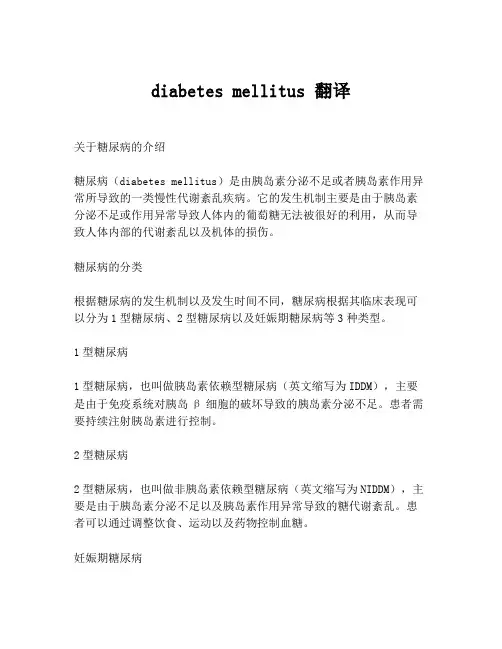
diabetes mellitus 翻译关于糖尿病的介绍糖尿病(diabetes mellitus)是由胰岛素分泌不足或者胰岛素作用异常所导致的一类慢性代谢紊乱疾病。
它的发生机制主要是由于胰岛素分泌不足或作用异常导致人体内的葡萄糖无法被很好的利用,从而导致人体内部的代谢紊乱以及机体的损伤。
糖尿病的分类根据糖尿病的发生机制以及发生时间不同,糖尿病根据其临床表现可以分为1型糖尿病、2型糖尿病以及妊娠期糖尿病等3种类型。
1型糖尿病1型糖尿病,也叫做胰岛素依赖型糖尿病(英文缩写为IDDM),主要是由于免疫系统对胰岛β细胞的破坏导致的胰岛素分泌不足。
患者需要持续注射胰岛素进行控制。
2型糖尿病2型糖尿病,也叫做非胰岛素依赖型糖尿病(英文缩写为NIDDM),主要是由于胰岛素分泌不足以及胰岛素作用异常导致的糖代谢紊乱。
患者可以通过调整饮食、运动以及药物控制血糖。
妊娠期糖尿病妊娠期糖尿病是指孕期发生的糖代谢紊乱,妊娠期糖尿病的特点是妊娠后期症状较明显,出现频率较高,但是大多数患者在产后都会痊愈。
糖尿病的症状表现糖尿病患者会出现头痛、口渴、口干、多饮、多食等症状,还有特别的是尿多、尿频、尿糖、夜尿增多等表现。
如果没有及时有效的治疗,糖尿病会引起严重的健康问题,比如心脏病、脑卒中、肾功能不全、失明、足部坏疽等。
糖尿病的预防和治疗糖尿病的预防和治疗都需要患者保持良好的生活习惯,比如要保持饮食均衡、正常体重、适当运动、不吸烟等。
如果患者已经发生了糖尿病,需要及时的接受医学治疗。
根据不同型号的糖尿病,医生会制定不同的治疗方案,包括饮食调整、运动锻炼和药物治疗等。
总之,糖尿病是一种很危险的疾病,患者需要做好自我管理,加强自我监测和药物治疗,才能够控制病情。
如果出现了糖尿病所引发的严重并发症,那么患者就需要通过手术治疗等手段进行治疗。
因此,及早预防和治疗糖尿病尤为关键。
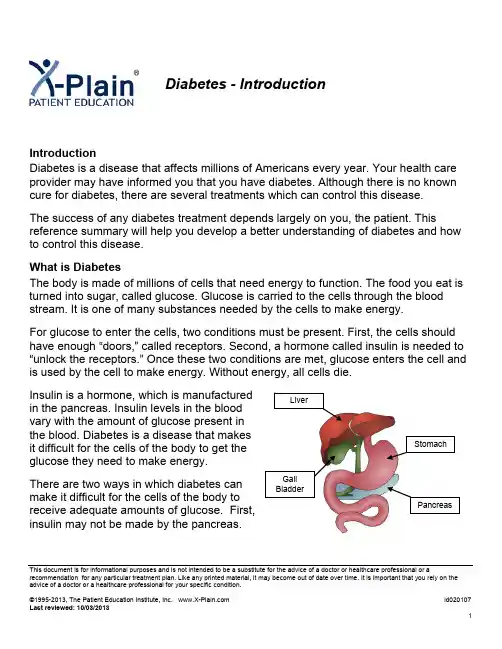
Diabetes - IntroductionIntroductionDiabetes is a disease that affects millions of Americans every year. Your health care provider may have informed you that you have diabetes. Although there is no known cure for diabetes, there are several treatments which can control this disease. The success of any diabetes treatment depends largely on you, the patient. This reference summary will help you develop a better understanding of diabetes and how to control this disease.What is DiabetesThe body is made of millions of cells that need energy to function. The food you eat is turned into sugar, called glucose. Glucose is carried to the cells through the blood stream. It is one of many substances needed by the cells to make energy.For glucose to enter the cells, two conditions must be present. First, the cells should have enough “doors,” called receptors. Second, a hormone called insulin is needed to “unlock the receptors.” Once these two conditions are met, glucose enters the cell and is used by the cell to make energy. Without energy, all cells die.Insulin is a hormone, which is manufacturedin the pancreas. Insulin levels in the bloodvary with the amount of glucose present inthe blood. Diabetes is a disease that makesit difficult for the cells of the body to get theglucose they need to make energy.There are two ways in which diabetes canmake it difficult for the cells of the body toreceive adequate amounts of glucose. First,insulin may not be made by the pancreas.This document is for informational purposes and is not intended to be a substitute for the advice of a doctor or healthcare professional or a recommendation for any particular treatment plan. Like any printed material, it may become out of date over time. It is important that you rely on the advice of a doctor or a healthcare professional for your specific condition.Because insulin is needed to “unlock the receptors,” glucose cannot enter the cells. Therefore, glucose levels increase in the blood. This is known as Type 1 diabetes. Type 2 diabetes occurs when insulin is present in enough quantities, but there is a decrease in the number of receptors on the cells to allow glucose to enter. Even though insulin is present, it cannot be used effectively, a situation called “Insulin Resistance” and results in high levels of glucose in the blood.Type 2 diabetes is more common than Type 1. The exact causes of diabetes are unknown. However, it tends to run in families. Diabetes is not contagious.Signs and Symptoms Of DiabetesDiabetes is detected when your health care provider finds a high level of sugar in your blood or urine. The most reliable test results are obtained when the sugar level in the blood is checked before any food or liquid is ingested. This is known as a fasting blood sugar. A range for a normal fasting blood sugar is between 60 and 99 mg/dL. Levels between 100 and 125 mg/dL are considered pre-diabetic levels.Common signs and symptoms of diabetesinclude:•Excessive thirst.• Frequent urination.• Excessive Hunger.• Weight loss.• Fatigue.• Changes in vision.•Slow-healing cuts or infections.•Persistent itching of the skin.Treatment OptionsDiabetes cannot be cured. It can, however, be controlled by keeping the level of glucose in the blood within its normal range. The treatment and management of diabetes varies from patient to patient. Your health care provider and diabetic care team will decide what form of treatment is best for you.The success of your treatment depends largely on you. When you learn AND practice how to control your glucose level, you will enjoy a healthier life.This document is for informational purposes and is not intended to be a substitute for the advice of a doctor or healthcare professional or a recommendation for any particular treatment plan. Like any printed material, it may become out of date over time. It is important that you rely on the advice of a doctor or a healthcare professional for your specific condition.Controlling DiabetesYou can control diabetes by:This document is for informational purposes and is not intended to be a substitute for the advice of a doctor or healthcare professional or arecommendation for any particular treatment plan. Like any printed material, it may become out of date over time. It is important that you rely on the advice of a doctor or a healthcare professional for your specific condition.1. Eating right.2. Exercising.3. Monitoring your blood glucose level.4. Taking prescribed medications.5. Learning about diabetes.Your dietitian or diabetes educator will explain to you howyou can plan your meals and answer any questions youmay have. The three goals of eating right are:1. Controlling your weight2. Keeping the level of blood glucose at normal levels,and3. Reducing fat in the body.A healthy diet may include changing what you eat, howmuch you eat, and how often you eat. However, you maybe surprised by how many healthy and tasty food options you have.Exercise helps people with diabetes in many ways. It lowers glucose levels, helps weight-loss, and maintains a healthy heart and circulation. In addition, exercisinghelps relieve stress and strengthens muscles. Your health care team will discuss your exercise plan with you. Always check with your health care team before starting a new exercise program.Blood glucose testing is important to find out if your blood glucose level is where itshould be. If your blood glucose is too low or too high, you may need a change in your diabetes medication, diet, or exercise plan. If a change is needed, your health care provider or diabetic care team will give you instructions on what you should do. Your blood glucose level is determined by testing asmall drop of blood obtained from one of your fingers.This drop of blood is obtained by sticking your fingerwith a lancet. Blood glucose is usually checked one tofour times each day, usually before meals. This can bedone at home. Most people with diabetes become verycompetent at checking their own blood glucose.Your diabetes educator will teach you how to test your blood glucose correctly and will tell you the times of day to do the tests. He or she will also teach you how to make changes in diabetes medication, diet, or exercise to help control your blood glucose. The diabetes educator will also review your blood glucose records and make any necessary changes in your therapy.In cases of very high blood glucose levels that do not respond to diet and exercise plans, medications may be needed. You health care provider will tell you if you need medications or insulin. If insulin is needed, it can onlybe injected. Insulin is needed for all patients with Type1 diabetes and for some patients with Type2 diabetes.Blood glucose levels are very important to determinewhether diabetes is controlled at the specific time theblood test is done. There is also another blood testknown as Hemoglobin A1C. This blood test determineshow well glucose has been controlled over the previous3 months. A normal level in people who do not have diabetes is usually 5% or less.People with diabetes should try to maintain their Hemoglobin A1C at 6% or less as long as they don’t have symptoms of hypoglycemia. A 6% level is equivalent to an estimated average blood sugar of 126 mg/dL. The lower the Hemoglobin A1C is, the less the chances of having complications from diabetes.Hyperglycemia (High Blood Sugar)When controlling your diabetes, your blood glucose can become too high or too low. These conditions should be taken seriously. Fortunately, you can regain control of your blood glucose.When too much sugar is in your blood, this condition is called hyperglycemia. Hyper is Greek and means “more.” Glycemia is also Greek and means, "sugar in the blood." Hyperglycemia can be caused by eating too much food, eating sugary, sweet foods, or by not taking your medication. It can also happen when you are sick. If not treated, hyperglycemia can cause you to go into a coma.This document is for informational purposes and is not intended to be a substitute for the advice of a doctor or healthcare professional or a recommendation for any particular treatment plan. Like any printed material, it may become out of date over time. It is important that you rely on the advice of a doctor or a healthcare professional for your specific condition.Signs of high blood sugar, or hyperglycemia, include:This document is for informational purposes and is not intended to be a substitute for the advice of a doctor or healthcare professional or arecommendation for any particular treatment plan. Like any printed material, it may become out of date over time. It is important that you rely on the advice of a doctor or a healthcare professional for your specific condition.• Dry mouth.• Thirst.• Frequent urination.• Blurry vision.• Fatigue or drowsiness.• Weight loss.When you have high blood glucose, drink water or othersugar-free liquids. Check your blood glucose and stick toyour diet plan. If your blood glucose remains high callyour health care team. Your health care team will tell you what is considered high foryou. If it is too high, you may need to go to the hospital.Hypoglycemia (Low Blood Sugar)Hypoglycemia occurs when too little glucose is present in your blood. Hypo is Greek and means “less.” Hypoglycemia usually occurs with patients who take insulin or other medications. It can be caused by taking too much insulin. That is why it is also known as insulin shock. It can also be caused when you decrease your food intake or skip a meal, or when you exercise more than usual.Signs of low blood sugar, or hypoglycemia, include:• Sweating, shaking, nervousness.• Hunger, dizziness, faintness.• Pounding heart, personality change, confused thinking,impatience, crankiness.• Numbness of lips and tongue, headache, blurred vision,and slurred or slowed speech.If not treated, low blood sugar can lead to fainting or seizures. Alow blood sugar can happen quickly and be life threatening.People with diabetes experience different signs when theirblood glucose is low. You should become aware of how youfeel when your blood glucose is too low. Some patients do notexperience any signs when their blood glucose is low.These patients must depend on blood glucose testing to find out if they have hypoglycemia.If you have low blood glucose, immediately eat or drink something containing fast-acting glucose. Examples include any of the following: 3-4 glucose tables, half a cup of fruit juice, 1/2 can of regular soda pop, ten gumdrops, or 2 teaspoons of sugar or honey. If your symptoms do not disappear in 15 minutes or your blood glucose remains less than 80 mg/dL, take another dose of fast-acting sugar. Repeat every 10 to 15 minutes until the blood glucose is greater than 80.If it is less than 30 minutes until your next meal, eat that meal. If it is more than 30 minutes, eat a snack such as half a sandwich or 3 Graham Crackers. Eat the meal or snack after you have taken a dose of fast-acting sugar. Do not subtract the snack from your next meal plan.Do not drive or operate equipment if you feel your blood glucose is low. You should inform your family members and friends that you have diabetes, and if they ever find you unconscious or not making sense, they should take you to a hospital immediately or call “911.”Complications of DiabetesWhen you control the level of glucose in your blood, the signs of diabetes become less frequent. You will feel better and have more energy. If you do not follow your diet, exercise, and perform blood glucose tests, serious complications can arise. Complications of diabetes include damage to the nerves and blood vessels of the body.Nerve damage is known as diabetic neuropathy. It usuallyinvolves the nerves going to the legs and feet. The feet orlegs could feel numb or unusually cold. Non traumaticlower limb amputations can occur in people withuncontrolled diabetes.People with diabetes who have poor sensation in theirfeet must be very careful to avoid damaging their feet withill-fitting shoes, hot water, or other forms of injury. Checkyour feet every day for cuts, sores, redness, or swelling.Use a mirror if needed.This document is for informational purposes and is not intended to be a substitute for the advice of a doctor or healthcare professional or a recommendation for any particular treatment plan. Like any printed material, it may become out of date over time. It is important that you rely on the advice of a doctor or a healthcare professional for your specific condition.When visiting the clinic, ask your health care provider to check your feet.Sexual dysfunction can occur. In men with diabetes, the most common problem is impotence due to damaged nerves going to the sexual organs. Urologists can help treat impotence with surgical and non-surgical treatments. In women with diabetes, damaged nerves in the pelvic organs and genitals can lead to impaired sexual arousal and painful intercourse. If this happens, your health care provider can recommend a treatment.Because the nerves that go to the heart may be affected, people with diabetes who have a heart attack may not experience the typically described chest pain. People with diabetes should therefore be very suspicious when they feel chest heaviness, arm numbness or indigestion. These could be symptoms of a heart attack. Adults with diabetes have heart disease death rates 2 to 4 times higher than adults without diabetes. The risk of stroke is 2 to 4 times higher among people with diabetes.High blood glucose can cause damage to large and small blood vessels. Fat in the blood is deposited on the walls of blood vessels. This causes hardening of the arteries or arteriosclerosis. Hardening of the arteries can occur in arteries leaving or entering the heart. It can also occur in the legs.Your diet plan is designed to lower the level of fat and cholesterol in the blood. When small blood vessels are narrowed by plaque and fat, the blood flow to the organs becomes insufficient. This causes the death of cells dependent on receiving the blood. It can also cause bleeding from narrowed blood vessels.The thickening of small blood vessels is mostnoticeable in the kidney and in the back of the eye.Diabetes is the leading cause of new cases ofblindness among adults.Diabetes may stop the kidneys from cleaning wasteout of the blood. In addition, proteins that shouldstay in the body may leak into the urine. Yourhealth care provider can test for small amounts ofprotein in your urine to determine if there are earlysigns of kidney diseases. Diabetes is the leading cause of kidney failure.This document is for informational purposes and is not intended to be a substitute for the advice of a doctor or healthcare professional or a recommendation for any particular treatment plan. Like any printed material, it may become out of date over time. It is important that you rely on the advice of a doctor or a healthcare professional for your specific condition.People with diabetic kidney disease often develop high blood pressure. It is very important that the high blood pressure be treated with blood pressure lowering medicines because this helps to prevent worsening of the kidney problems.If you have diabetic kidney disease, your health care provider may also prescribe a special diet that is low in protein and restricted in salt. In rare cases, dialysis and even kidney transplants may become necessary.Gum disease is more common in people with diabetes. Among young adults, those with diabetes have about twice the risk of gum disease as those without diabetes. If you have diabetes and smoke, talk to you health care provider about smoking cessation support.All health care providers feel that controlling your diabetes will help prevent damage to blood vessels and nerves. Proper control of diabetes is a combination of diet plan, medication, exercise, blood glucose monitoring, and good hygiene.SummaryThanks to advances in medicine, diabetes can be successfully controlled. The role of the patient is essential in making a diabetes management plan succeed.Diabetes management consists of:This document is for informational purposes and is not intended to be a substitute for the advice of a doctor or healthcare professional or arecommendation for any particular treatment plan. Like any printed material, it may become out of date over time. It is important that you rely on the advice of a doctor or a healthcare professional for your specific condition.• Following a diet plan• Testing blood sugar• Exercising• Taking all prescribed medication on time• Ensuring good hygiene• Learning about diabetesYour diabetic health care team will explain to you yourspecific diabetes control plan. When you follow these instructions, the possibility of experiencing the problems of diabetes discussed in this program can be significantlyreduced.This reference summary is made available to you by your health care team to help you enjoy a healthier lifestyle while controlling diabetes.。
糖尿病英文作文英文:Diabetes is a chronic disease that affects millions of people worldwide. It occurs when the body is unable to produce or properly use insulin, a hormone that regulates blood sugar levels. As a result, people with diabetes have high blood sugar levels, which can lead to a range of health problems if left untreated.Personally, I have a family history of diabetes, so I have always been aware of the importance of maintaining a healthy lifestyle to prevent the onset of the disease. This includes eating a balanced diet, exercising regularly, and monitoring my blood sugar levels.One of the challenges of living with diabetes is managing blood sugar levels throughout the day. I have to be mindful of what I eat and how much I exercise, as both of these factors can affect my blood sugar levels. I alsohave to monitor my blood sugar levels regularly and adjust my medication as needed.However, with the right management and support, people with diabetes can lead healthy, fulfilling lives. It's important to remember that diabetes is a manageable condition, and with the right care, people with diabetescan live long and healthy lives.中文:糖尿病是一种慢性疾病,影响着全球数百万人。
糖尿病基础知识英文Diabetes Mellitus: An OverviewIntroductionDiabetes mellitus, commonly referred to as diabetes, is a chronic metabolic disorder that affects millions of people worldwide. It is characterized by elevated levels of blood sugar, either due to the body's inability to produce enough insulin or the ineffective use of insulin. In this article, we will explore the basic knowledge of diabetes mellitus, including its types, symptoms, causes, and management.Types of Diabetes MellitusThere are three main types of diabetes mellitus: type 1 diabetes, type 2 diabetes, and gestational diabetes.Type 1 DiabetesType 1 diabetes, also known as insulin-dependent diabetes, typically develops during childhood or adolescence. It occurs when the body's immune system attacks and destroys the insulin-producing cells in the pancreas. Individuals with type 1 diabetes require regular insulin injections to manage their blood sugar levels.Type 2 DiabetesType 2 diabetes, the most common form of diabetes, usually develops later in life, although it is increasingly being diagnosed in children and adolescents. In type 2 diabetes, the body becomes resistant to the effects of insulin or does not produce enough insulin to meet the body's needs.Lifestyle factors, such as obesity and sedentary behavior, contribute to the development of type 2 diabetes.Gestational DiabetesGestational diabetes occurs only during pregnancy and is characterized by high blood sugar levels. Although it usually resolves after childbirth, women who have had gestational diabetes are at an increased risk of developing type 2 diabetes later in life.Symptoms of Diabetes MellitusSome common symptoms of diabetes mellitus include:1. Excessive thirst and frequent urination: Elevated blood sugar levels cause the kidneys to work harder, resulting in increased fluid consumption and frequent urination.2. Fatigue: Cells are unable to effectively utilize glucose for energy, leading to persistent tiredness and lack of energy.3. Unexplained weight loss: Despite increased appetite, individuals with diabetes may experience weight loss due to the body's inability to properly store and use glucose.4. Blurred vision: High blood sugar levels can affect the lens of the eye, leading to blurred vision.5. Slow wound healing: Diabetes impairs the body's ability to heal wounds, increasing the risk of infections.6. Recurring infections: Elevated blood sugar levels weaken the immune system, making individuals more susceptible to infections, especially urinary tract and skin infections.Causes of Diabetes MellitusType 1 diabetes is believed to be an autoimmune disease in which the body's immune system mistakenly attacks the insulin-producing cells in the pancreas. The exact causes of type 1 diabetes remain unknown, but genetic and environmental factors are thought to play a role.Type 2 diabetes is primarily caused by a combination of genetic and lifestyle factors. Obesity, sedentary lifestyle, poor dietary choices, and family history of diabetes are some of the contributing factors.Gestational diabetes is believed to occur due to hormonal changes during pregnancy, which can impact insulin production and utilization.Management of Diabetes MellitusThe management of diabetes mellitus revolves around maintaining blood sugar levels within a target range. This is typically achieved through a combination of medications, lifestyle modifications, and regular monitoring.MedicationsType 1 diabetes requires insulin therapy, usually through multiple daily injections or an insulin pump. Type 2 diabetes may be managed initially through lifestyle changes, but medication, including oral medication or insulin injections, may be prescribed if blood sugar levels remain elevated.Lifestyle ModificationsA healthy diet, regular exercise, and weight management are essential components of diabetes management. A diet rich in fruits, vegetables, lean proteins, and whole grains can help regulate blood sugar levels. Regular physical activity improves insulin sensitivity and helps maintain a healthy weight.MonitoringRegular monitoring of blood sugar levels is crucial for individuals with diabetes. Self-monitoring of blood glucose levels using a glucometer allows individuals to make necessary adjustments in medication, diet, or physical activity to maintain optimal blood sugar control.ConclusionDiabetes mellitus is a chronic metabolic disorder that requires lifelong management. Understanding the types, symptoms, causes, and management strategies is vital for individuals with diabetes to lead healthy lives. By closely monitoring blood sugar levels, adhering to medication and lifestyle modifications, and seeking regular medical care, individuals with diabetes can effectively manage their condition and minimize the risk of complications.。
英文介绍糖尿病Diabetes is a chronic medical condition that affects how your body turns food into energy. There are two main types of diabetes: type 1 and type 2. In type 1 diabetes, the body does not produce insulin, a hormone necessary for regulating blood sugar levels. This type of diabetes is usually diagnosed in children and young adults, and it requires lifelong insulin therapy. Type 2 diabetes, on the other hand, occurs when the body becomes resistant to insulin or does not produce enough insulin. This type of diabetes is more common in adults and is often linked to lifestyle factors such as obesity and lack of physical activity.One of the key symptoms of diabetes is high blood sugar levels, which can lead to a range of complications if not properly managed. These complications can include heart disease, stroke, kidney disease, nerve damage, and vision problems. It is important for individuals with diabetes to monitor their blood sugar levels regularly and follow atreatment plan prescribed by their healthcare provider. This may include taking medication, following a healthy diet, exercising regularly, and monitoring blood sugar levels.Diabetes management also involves making lifestyle changes to help control blood sugar levels and prevent complications. This can include maintaining a healthy weight, eating a balanced diet rich in fruits, vegetables, and whole grains, and getting regular physical activity. It is also important to avoid smoking and limit alcohol consumption, as these habits can worsen diabetes symptoms and increase the risk of complications. Additionally, individuals with diabetes should work closely with their healthcare team to develop a personalized treatment plan that meets their needs and helps them achieve their health goals.In addition to lifestyle changes, individuals with diabetes may also need to take medication to help manage their condition. This can include insulin injections, oral medications, or other treatments to help control bloodsugar levels. It is important for individuals with diabetes to take their medication as prescribed and to monitor their blood sugar levels regularly to ensure that their condition is well-managed. In some cases, individuals with diabetes may also need to use devices such as insulin pumps or continuous glucose monitors to help monitor and control their blood sugar levels.Overall, diabetes is a complex and chronic condition that requires ongoing management and care. By making lifestyle changes, following a treatment plan, and working closely with healthcare providers, individuals with diabetes can effectively manage their condition and reduce the risk of complications. It is important for individuals with diabetes to stay informed about their condition, seek support from healthcare providers and loved ones, and take an active role in their own health to live a full and healthy life with diabetes.。
疾病知识科普英文作文英文:Disease knowledge is essential for everyone. It helps us to understand how our body works and how to take care of it. In this article, I will share some important disease knowledge with you.Firstly, let's talk about the common cold. The common cold is a viral infection that affects the upperrespiratory tract. It is highly contagious and can be transmitted through the air or by touching contaminated surfaces. Symptoms of the common cold include coughing, sneezing, runny nose, sore throat, and fever. To prevent the common cold, you should wash your hands frequently, avoid close contact with sick people, and cover your nose and mouth when you cough or sneeze.Secondly, let's discuss diabetes. Diabetes is a chronic disease that affects the way your body processes bloodsugar. There are two types of diabetes: type 1 and type 2. Type 1 diabetes is usually diagnosed in children and young adults and occurs when the body does not produce enough insulin. Type 2 diabetes is more common and occurs when the body becomes resistant to insulin. Symptoms of diabetes include frequent urination, thirst, hunger, fatigue, and blurred vision. To prevent diabetes, you should maintain a healthy weight, exercise regularly, and eat a balanced diet.Lastly, let's talk about heart disease. Heart diseaseis a broad term used to describe a range of conditions that affect the heart. The most common type of heart disease is coronary artery disease, which occurs when the arteriesthat supply blood to the heart become narrow or blocked. Symptoms of heart disease include chest pain, shortness of breath, and fatigue. To prevent heart disease, you should exercise regularly, eat a heart-healthy diet, quit smoking, and manage stress.中文:疾病知识对每个人来说都至关重要。
Diabetes mellitus
Diabetes mellitus (DM), commonly referred to as diabetes, is a group of metabolic diseas es in which there are high blood sugar levels over a prolonged period.
Symptoms of high blood sugar include frequent urination, increased thirst, and increased hunger. If left untreated, diabetes can cause many complications. Acute complications ca n include diabetic ketoacidosis(酮症酸中毒), nonketotic hyperosmolar coma(高糖昏迷), or death. Serious long-term complications include heart disease, stroke, chronic kidney f ailure, foot ulcers, and damage to the eyes.
Diabetes is due to either the pancreas not producing enough insulin or the cells of the body not responding properly to the insulin produced.There are three main types of diab etes mellitus:
Type 1 DM results from the pancreas's failure to produce enough insulin.
Type 2 DM begins with insulin resistance
Gestational diabetes is the third main form and occurs when pregnant women without a previous history of diabetes develop high blood-sugar levels.
Prevention and treatment involve maintaining a healthy diet, regular physical exercise, a normal body weight, and avoiding use of tobacco. Control of blood pressure and maintai ning proper foot care are important for people with the disease. Type 1 DM must be m anaged with insulin injections.Type 2 DM may be treated with medications with or witho ut insulin.Insulin and some oral medications can cause low blood sugar.Weight loss surger y in those with obesity is sometimes an effective measure in those with type 2 DM.Gest ational diabetes usually resolves after the birth of the baby.。